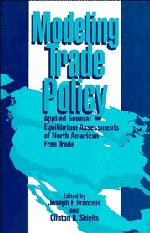Book contents
- Frontmatter
- Contents
- List of Contributors
- Dedication
- Part I Introduction
- Part II Multisector Models
- 2 A General Equilibrium Analysis of North American Economic Integration
- 3 The Gains for Mexico from a North American Free Trade Agreement – An Applied General Equilibrium Assessment
- 4 Some Applied General Equilibrium Estimates of the Impact of a North American Free Trade Agreement on Canada
- 5 Properties of Applied General Equilibrium Trade Models with Monopolistic Competition and Foreign Direct Investment
- Part III Sector-Focused Models
- Part IV Dynamic Models
- Index
3 - The Gains for Mexico from a North American Free Trade Agreement – An Applied General Equilibrium Assessment
Published online by Cambridge University Press: 25 March 2010
- Frontmatter
- Contents
- List of Contributors
- Dedication
- Part I Introduction
- Part II Multisector Models
- 2 A General Equilibrium Analysis of North American Economic Integration
- 3 The Gains for Mexico from a North American Free Trade Agreement – An Applied General Equilibrium Assessment
- 4 Some Applied General Equilibrium Estimates of the Impact of a North American Free Trade Agreement on Canada
- 5 Properties of Applied General Equilibrium Trade Models with Monopolistic Competition and Foreign Direct Investment
- Part III Sector-Focused Models
- Part IV Dynamic Models
- Index
Summary
Introduction
This chapter attempts to evaluate the effects that an eventual North American Free Trade Agreement (NAFTA) between Mexico, Canada, and the United States would have on the Mexican economy, in the presence of economies of scale in the Mexican industry. For that purpose, we show the results of an applied general equilibrium model for Mexico, in which the treatment of economies of scale follows the lines of the Harris (1984) model for Canada. Likewise, it is important to mention that, unlike the results shown in Sobarzo (1992), the present version deals with the removal of both tariff and nontariff barriers (NTBs).
This chapter is organized as follows. Section II presents a brief review on trade policy in Mexico. Section III describes the characteristics of the model. Section IV comments on the main findings. Finally, Section V contains some concluding remarks as well as some comments on the limitations of the approach.
Trade Policy
In 1983, after the debt crisis, the Mexican government conducted extensive trade liberalization that has taken the economy from being one of the most protected in the 1970s to one of the most open by the 1990s. Such measures were implemented in three stages.
In the first stage, from 1983 to 1985, the de la Madrid administration gradually opened the market to foreign participation by simplifying the tariff schedule, reducing the import licensing requirements, and reducing the number of items with official prices.
- Type
- Chapter
- Information
- Modeling Trade PolicyApplied General Equilibrium Assessments of North American Free Trade, pp. 83 - 99Publisher: Cambridge University PressPrint publication year: 1994
- 3
- Cited by



